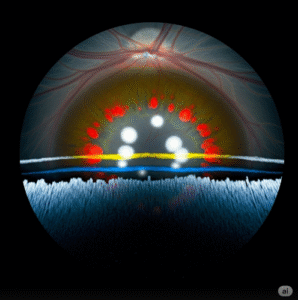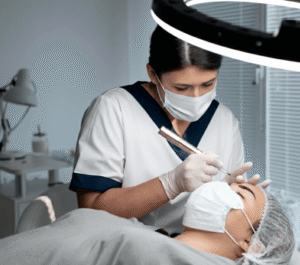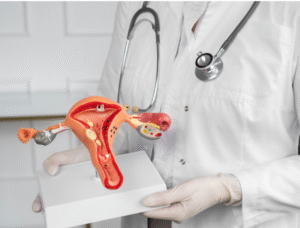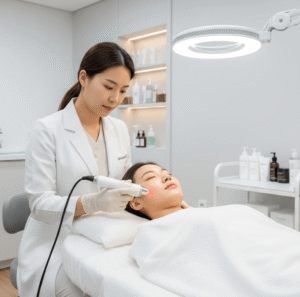Overview
Trabeculectomy is a surgical procedure used to treat glaucoma, a condition characterized by increased intraocular pressure (IOP) that can damage the optic nerve and lead to vision loss. The procedure creates a new drainage pathway for aqueous humor (fluid in the eye) to lower eye pressure and preserve vision.
In Korea, trabeculectomy is performed at specialized ophthalmology centers using advanced microsurgical techniques, ensuring high success rates, minimal complications, and comprehensive post-operative care.
What is Trabeculectomy?
Trabeculectomy is a glaucoma surgery in which a small flap is created in the sclera (white part of the eye) and a reservoir (bleb) is formed under the conjunctiva to allow aqueous humor to drain out of the eye.
Indications include:
- ✦ Open-angle glaucoma uncontrolled by medications or laser therapy
- ➤ Advanced glaucoma with high intraocular pressure
- ✦ Glaucoma progression despite maximum medical therapy
- ➤ Certain cases of secondary glaucoma
Benefits include:
- Effective reduction of intraocular pressure
- Preservation of vision and prevention of optic nerve damage
- Long-term control of glaucoma progression
What are the Benefits?
✅ Significant reduction in intraocular pressure
➤ Slows or halts the progression of glaucoma
✅ Reduces reliance on eye drops or medications
➤ Can improve quality of life by simplifying glaucoma management
✅ Safe and widely practiced in Korea with modern microsurgical techniques
Procedure Details
1) How should I prepare for Trabeculectomy?
- ✦ Comprehensive eye examination including visual field and optic nerve imaging
- ➤ Blood pressure and systemic health assessment
- ✦ Discontinue certain medications as advised by your ophthalmologist
- ➤ Arrange transportation; the procedure is usually done under local anesthesia with sedation
2) What happens during the procedure?
- ✦ Performed under local anesthesia
- ➤ A small flap is created in the sclera at the top of the eye
- ✦ A drainage pathway (trabeculectomy fistula) is created for aqueous humor
- ➤ The conjunctiva is closed over the flap, forming a filtering bleb
- ✦ Antifibrotic agents may be applied to prevent scarring
- ➤ Procedure duration: 30–60 minutes
3) What happens after Trabeculectomy?
- ✦ Patients usually go home the same day
- ➤ Eye patch or shield may be worn for protection
- ✦ Eye drops are prescribed to prevent infection and control inflammation
- ➤ Follow-up visits are scheduled frequently to monitor IOP and bleb function
- ✦ Full recovery of eye pressure stability may take 4–6 weeks
Risks / Benefits
Possible Risks:
- Infection (endophthalmitis)
- Hypotony (excessively low eye pressure)
- Scarring of the bleb reducing effectiveness
- Bleeding or vision changes
- Cataract development over time
Benefits:
- Long-term control of intraocular pressure
- Prevents further optic nerve damage and vision loss
- Reduces dependence on glaucoma medications
- In Korea, advanced microsurgical techniques maximize success and minimize complications
Recovery and Outlook
- ✦ Initial recovery: mild discomfort, redness, or blurred vision for a few days
- ➤ Eye drops are continued for several weeks as directed
- ✦ Avoid rubbing the eye or strenuous activity for 4–6 weeks
- ➤ Regular follow-up ensures bleb function and eye pressure control
- ✦ Most patients achieve stable IOP and long-term preservation of vision
When To Call the Doctor
⚠ Severe eye pain or sudden vision loss
⚠ Persistent redness or discharge
⚠ Signs of infection (fever, swelling, or pus)
⚠ Sudden decrease in vision or abnormal floaters
Best Korea Option / Process
Korean hospitals provide advanced glaucoma care, including:
- ✦ Experienced ophthalmic surgeons specializing in trabeculectomy
- ➤ Microsurgical precision to minimize complications
- ✦ Use of antifibrotic agents and modern techniques to enhance success
- ➤ Comprehensive post-operative care and follow-up
- ✦ Day-surgery with rapid recovery and frequent monitoring
- ➤ English-speaking coordinators for international patients
Highlights of Trabeculectomy in Korea
- ✅ Minimally invasive microsurgery for glaucoma
- ➤ Effective long-term control of intraocular pressure
- ✅ Reduces reliance on glaucoma medications
- ➤ High success rates with skilled Korean ophthalmologists
- ✅ Comprehensive post-operative monitoring and care













